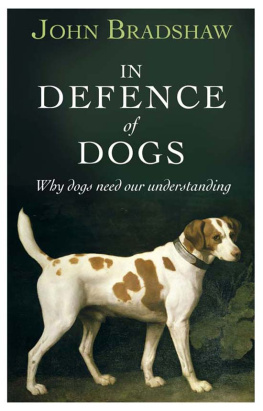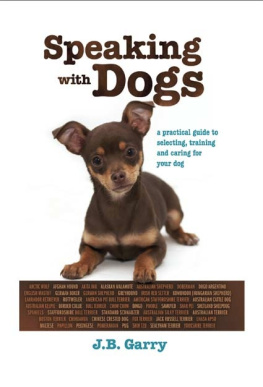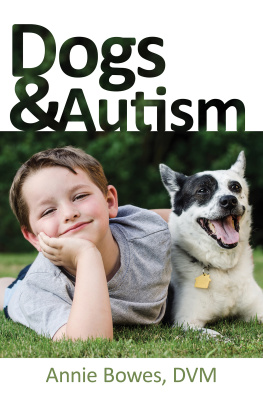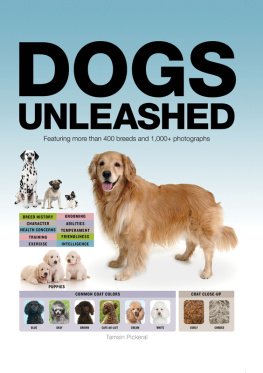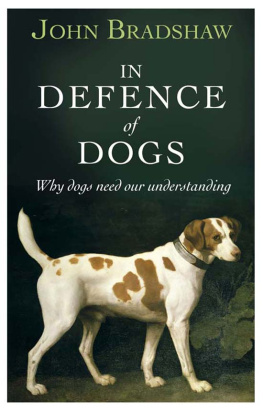JOHN BRADSHAW
In Defence of Dogs

ALLEN LANE
an imprint of
PENGUIN BOOKS
ALLEN LANE
Published by the Penguin Group
Penguin Books Ltd, 80 Strand, London WC2R 0RL, England
Penguin Group (USA) Inc., 375 Hudson Street, New York, New York 10014, USA
Penguin Group (Canada), 90 Eglinton Avenue East, Suite 700, Toronto, Ontario, Canada M4P 2Y3 (a division of Pearson Canada Inc.)
Penguin Ireland, 25 St Stephens Green, Dublin 2, Ireland (a division of Penguin Books Ltd)
Penguin Group (Australia), 250 Camberwell Road, Camberwell, Victoria 3124, Australia (a division of Pearson Australia Group Pty Ltd)
Penguin Books India Pvt Ltd, 11 Community Centre, Panchsheel Park, New Delhi 110 017, India
Penguin Group (NZ), 67 Apollo Drive, Rosedale, Auckland 0632, New Zealand (a division of Pearson New Zealand Ltd)
Penguin Books (South Africa) (Pty) Ltd, 24 Sturdee Avenue, Rosebank 2196, South Africa
Penguin Books Ltd, Registered Offices: 80 Strand, London WC2R 0RL, England
www.penguin.com
First published 2011
Copyright John Bradshaw, 2011
The moral right of the author has been asserted
All rights reserved. Without limiting the rights under copyright reserved above, no part of this publication may be reproduced, stored in or introduced into a retrieval system, or transmitted, in any form or by any means (electronic, mechanical, photocopying, recording or otherwise) without the prior written permission of both the copyright owner and the above publisher of this book
Typeset by Palimpsest Book Production Limited, Falkirk, Stirlingshire
ISBN: 978-1-846-14296-3
To Alexis (19701984) a Real Dog
List of Figures
Figures 19, 1114, 17, 18, 238, 323, 3641, 457, 4951 copyright Alan Peters.
Acknowledgements
Ive spent the best part of thirty years studying dog behaviour, first at the Waltham Centre for Pet Nutrition, then at the University of Southampton, and finally at the University of Bristols Anthrozoology Institute. Some of what Ive learned about dogs has come from direct observation, especially in the early days, but much has been informed by collaborations and discussions with many colleagues and graduate students. The original research described in this book owes much to them, though of course I take full responsibility for the interpretations presented here. In roughly chronological order, they are: Christopher Thorne, David Macdonald, Stephan Natynczuk, Benjamin Hart, Sarah Brown, Ian Robinson, Helen Nott, Stephen Wickens, Amanda Lea, Sue Hull, Sarah Whitehead, Gwen Bailey, James Serpell, Rory Putman, Anita Nightingale, Claire Hoskin, Robert Hubrecht, Claire Guest, Deborah Wells, Elizabeth Kershaw, AnneMcBride, Sarah Heath, Justine McPherson, David Appleby, Barbara Schning, Emily Blackwell, Jolanda Pluijmakers, Theresa Barlow, Helen Almey, Elly Hiby, Sara Jackson, Elizabeth Paul, Nicky Robertson, Claire Cooke, Samantha Gaines, Anne Pullen and Carri Westgarth and many more too numerous to list. Two deserve a special mention: Nicola Rooney, who in addition to producing consistently world-class research on dog behaviour and welfare for the past dozen years, has also been the social life and soul of my research group; and Rachel Casey, arguably the UKs leading veterinary behaviourist, and unarguably an indefatigable champion of evidence-based dog training and behavioural therapy. I am grateful to Emily Blackwell and Nicola Rooney for their comments on parts of the manuscript. My thanks also to the University of Bristols School of Veterinary Medicine, and especially Professors Christine Nicol and Mike Mendl, and Dr David Main, for nurturingthe Anthrozoology Institute and its research.
Our research has relied on the co-operation of literally thousands of volunteer dog owners and their dogs, to whom I express my gratitude. Also, much of our research would have been impossible without the facilities and co-operation offered by the UKs leading animal rehoming charities: Dogs Trust, the Blue Cross and the RSPCA.
There are many other academics and dog experts that Ive met only briefly, but whose published work has been an enormous inspiration. Many I have been able to mention specifically in the notes. Like any branch of science, the systematic study of dog behaviour embraces many approaches and opinions, and sometimes these can be expressed quite forcefully. Yet there is a crucial difference between canine science and canine folklore; scientists are ready to evaluate evidence gathered by others, and to change their opinions if that evaluation indicates that they should. Canine scientists are not in the business of peddling opinion as if it were fact; they contribute to a body of knowledge which, while never complete, continually gains strength from being the product of many heads and much discussion. I am grateful to them all, even those whose views are now largely discredited or unfashionable. Science advances through thereplacement of one hypothesis by another that better fits the data; without the first to act as a stimulus to creative thought, the second might never have been conceived.
Condensing all this science into a book of reasonable length has not been easy, but my agent Patrick Walsh, and Lara Heimert and Will Goodlad, my editors at Basic Books and Penguin respectively, have all taught me a great deal about how to aim for a wider audience than the academic community that I have mainly written for in the past.
Ive been amazed and delighted by how my old friend Alan Peters drawings have brought my descriptions of dogs and canids to life. Hes not only a wonderful artist, hes also a skilful gundog trainer (and falconer) and so was able to bring to the task a lifetimes experience of how dogs move and interact.
Finally, to my family. My wife Nicky has been an unwavering source of support throughout all the years of my academic career, and especially during the year or so it has taken me to write this book I cannot thank her enough. Thanks also to my brother Jeremy for giving me the encouragement to start this book in the first place. Netty, Emma and Pete, thank you for refreshing my brain with music; Tom and Jez likewise but with ales, Rioja and cricket.
Ginger
Preface
The first dog that I became attached to was one I never met. He was my grandfathers cairn terrier, Ginger a typical long-legged cairn of the early twentieth century, only a few generations removed from his working forebears. Ginger had died long before I was born, and I grew up in a pet-free household: stories about Ginger were, for a while, the nearest I came to having a dog of my own.
My grandfather, an architect, liked to walk. He walked to and from his office in the industrial city of Bradford, and to and from the churches and mill buildings he specialized in, but especially he walked for recreation, whether on the Yorkshire moors, or in the Lake District, or in Snowdonia. Whenever he could, he took Ginger with him. The family maintained that Ginger, who was taller than he should have been for his breed, had acquired his longer than average legs through all this exercise. Actually, in the photographs I have of him he looks quite typical of his breed, and not unlike the cairn chosen to play Toto in the 1939 movie The Wizard of Oz. It was not until much later on, when I became professionally interested in pedigree dogs, that I was struck by how much the breed had changed over the intervening decades, including becoming significantly shorter in the leg. I doubt many modern cairns wouldenjoy the amounts of exercise that my grandfather evidently relished, although cairns today are less prone to inherited diseases than many other breeds are.

